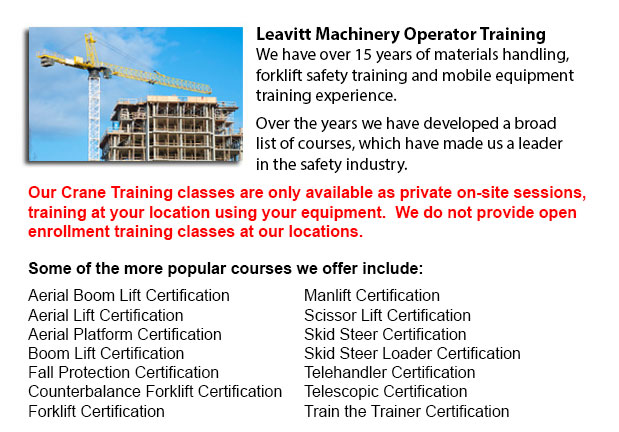
Overhead Crane Training Ottawa - The overhead crane is a piece of machine that could lift and move huge, heavy things which can't be handled manually. Usually, overhead cranes are fixed in position. These machines can be used in moving huge volumes of material. Overhead cranes are commonly used within steel mills so as to handle the steel during the process of fabrication. These cranes are seen at ports all around the world, moving things off and on ships.
Overhead cranes are designed to have a beam or rail permanently fixed on a support structure. A crane could be constructed right into a structure. Alternatively, a platform can be constructed to be able to hold the beam in position. The fixed design of overhead cranes gives them great stability, which allows them to handle the really heavy loads required in heavy businesses like for instance steel and shipping. Several makes of mobile overhead cranes are constructed to be pulled by huge vehicles.
The controls of an overhead crane are accessed via a mechanism which is mounted on a trolley, running along the rail. The overhead crane is limited to running just back and forth. Materials are lowered and lifted by running cable or rope through the device mounted on the trolley, and after that horizontally moved along the rail. This back and forth motion is sufficient. Like for instance, at a port, a container ship is located next to the crane, and the operator of the crane sends the mechanism back and forth along the trolley to shuttle merchandise between a train or truck and the ship. Jib cranes are a lot more flexible and have swinging booms for moving supplies in multiple directions.
The overhead crane's history goes back to the 1870s, at which time, there were some designs that were implemented in a variety of uses. There are smaller overhead cranes styles which are utilized in setting that require the lifting of heavy supplies. A home workshop, like for instance, may need the use of an overhead crane in order to shuttle finished products, tools and lumber between the workshop and loading area. Regardless of the use, overhead cranes should just be operated by those who have acquired overhead crane training.
-
Telehandler Ticket Ottawa
Telehandler Ticket Ottawa - The telehandler or telescopic handler is a commonly utilized equipment in industrial and agricultural applications. This machine is the same in look to a forklift and also functions in a similar manner, though telehandlers... More -
Telehandler License Ottawa
Telehandler License Ottawa - The telehandler or telescopic handler is a frequently used machine in industrial and agricultural applications. This particular equipment is the same in appearance to a forklift and even functions in a similar way, althou... More -
Forklift Training Courses Ottawa
Forklift Training Courses Ottawa - Our forklift operator safety training has been tailored for illiteracy, thus cutting the training time in half. We provide forklift training certification, lift-truck operator driver safety training evaluation, and... More -
Boom Lift Certification Ottawa
Boom Lift Certification Ottawa - Making use of elevated work platforms allow for work and maintenance operations to be carried out at elevated work heights which were otherwise unreachable. Workers using scissor lifts and boom lifts can be educated i... More -
Aerial Platform Training Ottawa
Aerial Platform Training Ottawa - Aerial lifts might be used to accomplish certain different duties done in hard to reach aerial spaces. Many of the tasks associated with this style of lift include performing routine upkeep on structures with high ce... More -
Loader Operator Certification Ottawa
Loader Operator Certification Ottawa - Ways To Acquire A Loader Operator Certification - Loader Operator Certification is normally needed for personnel working within construction, warehouse or industrial setting to ensure the safe operation of forkl... More -
Aerial Lift / Boom Lift / Man Lift / Scissor Lift Training in Ottawa
Lift tables or also referred to as scissor hoists can raise both individuals and goods vertically. They are normally utilized in commercial, industrial and construction environments. Commonly, the use of a scissor lift truck is to lift and lower thin... More -
Skid Steer Loader Training in Ottawa
The engine powered skid-steer loader comprises a small and rigid frame, equipped together with lift arms which can connect to lots of industrial attachments and tools so as to perform a wide variety of labor saving jobs. Usually, skid-steer loaders a... More

Forklift Training Ottawa
Ottawa, Ontario
forklifttrainingottawa.com
Email Us
About Us


